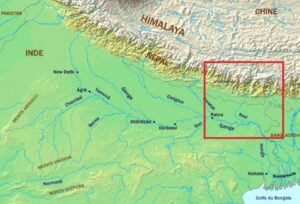Published on: October 22, 2023
Saptakoshi High Dam
Saptakoshi High Dam
Why in news? Nepal and India have agreed to reduce the height of the proposed Saptakoshi High Dam
Highlights:
- Height reduction mainly concerns in Nepal over the potential inundation of a large swathe of land upstream of the dam.
- The proposed hydropower generation from the multipurpose project will also decrease. The project is now expected to generate around 2,300MW, down from the earlier proposed 3,000MW.
- Reduction in dam height is mainly due to planned large storage hydropower projects in the tributaries of the Saptakoshi-Tamor, Sunkoshi and Dudhkoshi that regulate the water flow
About Saptakoshi High Dam
- It is also called Koshi High Dam
- Multipurpose project proposed to be constructed on the Saptakoshi River of Nepal.
- Aim: To control floods in south-east Nepal and northern Bihar of India, and to generate hydro power.
About Kosi River
- It is a transboundary river flows through China, Nepal and India.
- Source: Sun Kosi, Arun and Tamur Rivers form Saptakoshi
- It is the 3rd largest tributary of the Ganges by water discharge after Ghaghra and Yamuna.
- Kosi River is known as the “Sorrow of Bihar” as the annual floods affecting rural economy
Tributaries:
- Dudh Koshi, Likhu Khola, Tamakoshi River, Bhote Koshi, and Indravati.
- Kamala and Bagmati (Kareh) are the major tributaries of Kosi River in India
Catchment
- It covers six geological and climatic comprising the Tibetan plateau, the Himalayas, the Himalayan mid-hill belt, the Mahabharat Range, the Siwalik Hills and the Terai.
Kosi barrage
- It is also called Bhimnagar Barrage, was built between Indo-Nepal border.
- Project aims for irrigation, flood control and hydropower generation project on the Kosi River built under a bilateral agreement between Nepal and India
- The entire cost of the project was borne by India.
Biodiversity
- Sagarmatha National Park and Koshi Tappu Wildlife Reserve two protected areas are located in the Koshi River basin
Cultural Significance
- The Kosi was also called Kausika in Rigveda.
- This river is mentioned in the epic ‘Mahabharata’ as Kausiki.

